A block of mass 10 kg is placed on a horizontal frictionless surface and is attached to a cord which passes over two light frictionless pulleys as shown in the figure. The hanging block tied to the other end of the cord is initially at rest 2 m above the horizontal floor. If the hanging vlock strikes the floor 2 s after the system is released, then weight of the hanging block is ... (g=10ms−2) ,
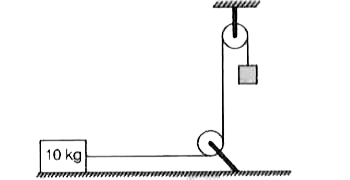 Solution in Telugu
Solution in Telugu
22.22 N
11.11 N
1.11 N
2.22 N
The correct Answer is:B
For hanging block,
s=ut+12at2[∵u=0]⇒2=12×a×22
⇒a=1ms−2
So, velocity of hanging block = velocity of 10 kg block after 2s
⇒v=u+at
⇒v=0+1×2 or v=2ms−1
From work -energy theorem, KE of 10 kg block =12×10×22=m×10×2
⇒m=1kg
Weight of hanging block =1×10=10kg≈111.1N
Topper's Solved these Questions
Similar Questions
A nucleus of deuterons or deuterium is a bound atomic system best described by
02:10View SolutionThe pressure on a circular plate is measured by measuring the force on the plate and the radius of the plate. If the errors in measurement of the force and the radius are 5% and 3% respectively, the percentage of error in the measurement of pressure is
03:14View SolutionA 4 kg block is on a smooth horizontal table. The block is connected to a second block of mass 1 kg by a massless flexible taut cord that passes over a frictionless pulley. The 1 kg block is 1m above the floor. The two block are released from rest. With what speed does the 1 kg block hit the ground? .
02:30View SolutionIn the figure shown, the mass of the hanging block is m, while that of the black resting on the floor is 3m. The floor is horizontal and frictionless and all pulleys ideal. The system is initially held stationary with the inclined thread making an angle θ=30∘ with the horizontal. The blocks are now released from rest and allowed to move. the hanging block falls through a height (49.5) m before hitting the floor. it is found that the value of θ becomes 60∘, when the hanging block hits the floor. Find the speed with which the hanging block hits the floor.
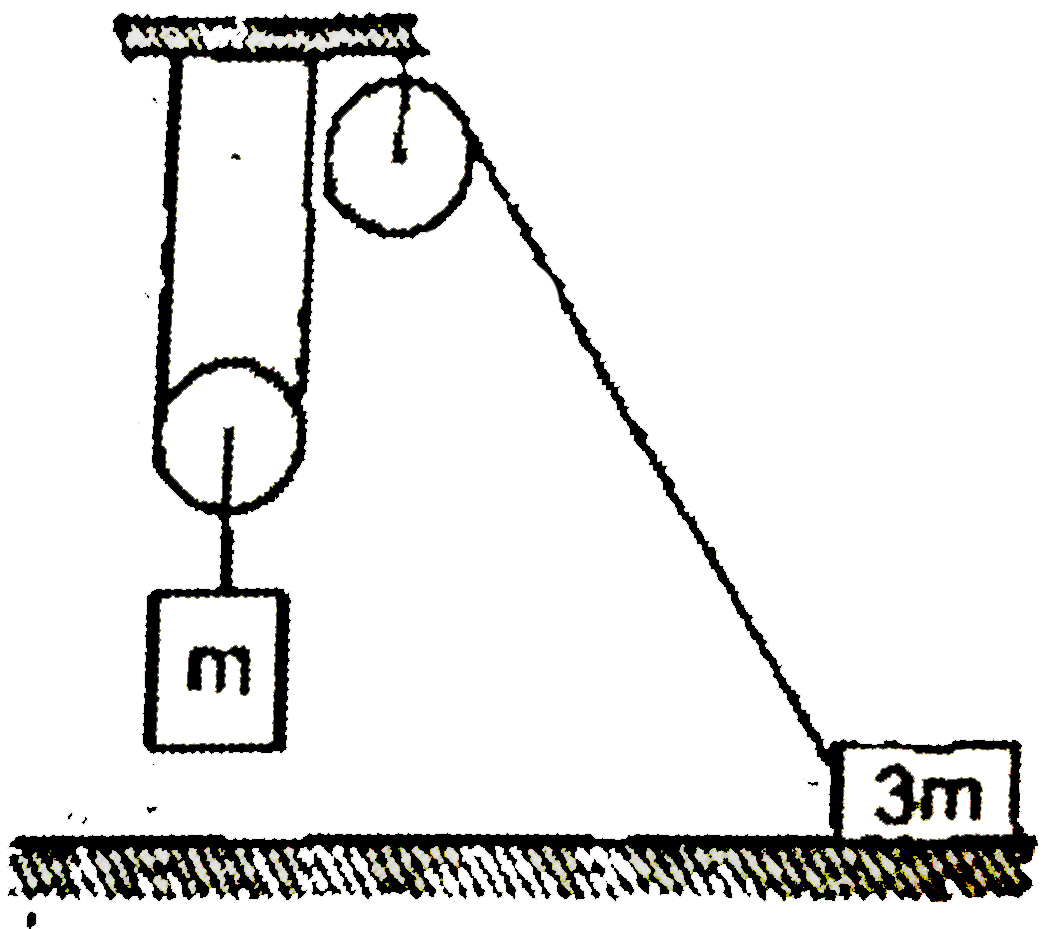 View Solution
View SolutionA 20 kg block placed on a level frictionless surface is attached to a cord which passes over two small frictionless pulleys,as shown in figure-2.167,to a hanging block originally at rest 1m above the floor. If the hanging block strikes the floor 2 s after the system is released, the weight of the hanging block is :
 01:44View Solution
01:44View SolutionA block of mass 5 kg resting on a horizontal surface is connected by a cord, passing over a light frictionless pulley to a hanging block of mass 5 kg. The coefficient of kinetic friction between the block and surface is 0.5. Tension in the cord is (take, g=9.8ms^(-2) )
06:15View SolutionTwo identical masses are attached by a light string that passes over a small pulley, as shown . The table and the pulley are frictionless. The hanging block is moving
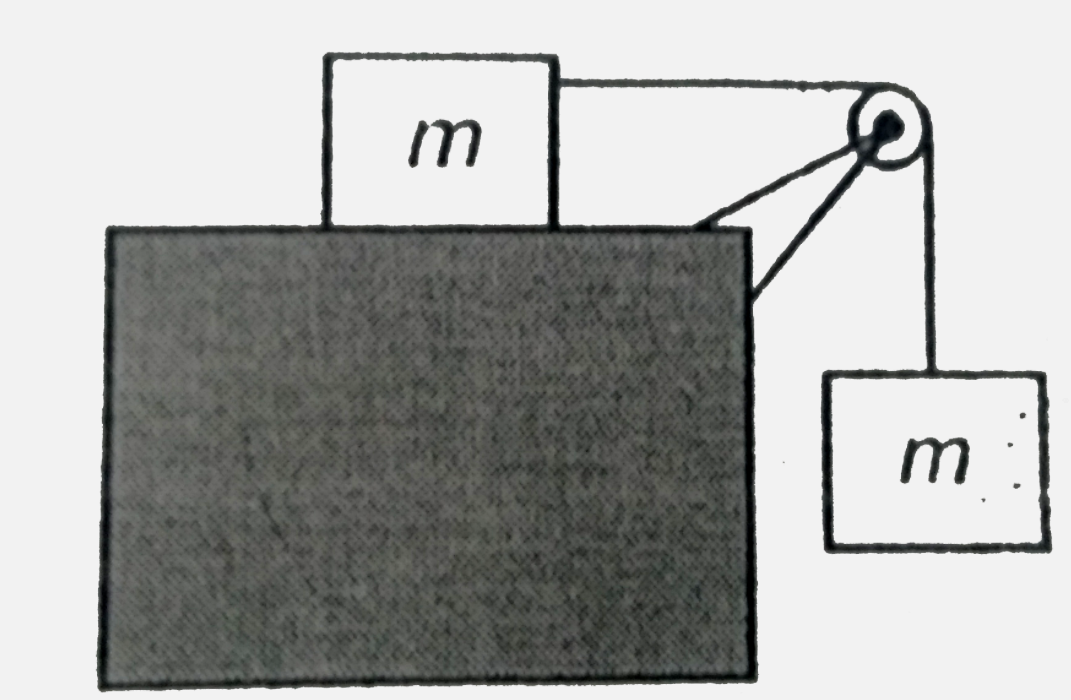 05:04View Solution
05:04View SolutionA block of mass 5 kg resting on a horizontal surface is connected by a cord, passing over a light frictionless pulley to a hanging block of mass 5 kg. The coefficient of kinetic friction between the block and the surface is 0.5. Tension in the cord is (g=9.8m/s2 )
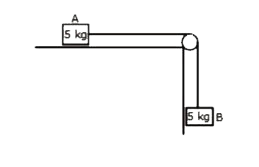 07:42View Solution
07:42View SolutionTwo blocks are connected by a cord passing over a small frictionless pulley and resting on frictionless planes as shown in the figure. The acceleration of the blocks is :
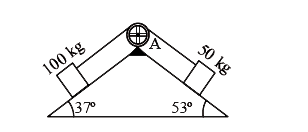 05:03View Solution
05:03View SolutionTwo blocks are connected by a cord passing over a small frictionless pulley and resting on frictionless planes as shown in the figure The accleration of the blocks is-
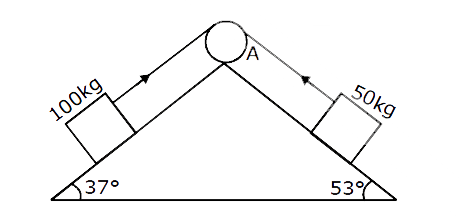 04:11View Solution
04:11View SolutionFigure 5-20 shows a block S (the sliding block) with mass M = 3.3 kg. The block is free to move along a horizontal frictionless surface and connected, by a cord that wraps over a frictionless pulley, to a second block H (the hanging block), with mass m = 2.1 kg. The cord and pulley have negligible masses compared to the blocks (they are "massless"). The hanging block H falls as the sliding block S accelerates to the right. Find (a) the acceleration of block S, (b) the acceleration of block H, and ( c ) the tension in the cord.
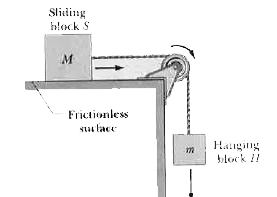
Figure 5.20 A block S of mass M is connected to a block H of mass m by a cord that wraps over a pulley.View SolutionA block of mass 3 kg which is on a smooth inclined plane making an angle of 30° to the horizontal is connected by a cord passing over a light frictionless pulley to a second block of mass 2 kg hanging vertically. What is the acceleration of each block and what is the tension of the cord?
04:11View SolutionA block of mass 3 kg which is on a smooth inclined plane making an angle of 30^(@) to the horizontal is connected by a cord passing over a light frictionless pulley to a second block of mass 2 kg hanging vertically. What is the acceleration of each block and what is the tension of the cord?
View SolutionA block of mass 3 kg which is on a smooth inclined plane making an angle of 30° to the horizontal is connected by a cord passing over a light frictionless pulley to a second block of mass 2 kg hanging vertically. What is the acceleration of each block and what is the tension of the cord?
02:43View SolutionA block of mass 3 kg which is on a smooth inclined plane making an angle of 30^(@) to the horizontal is connected by a cord passing over a light frictionless pulley to a second block of mass 2 kg hanging vertically. What is the acceleration of each block and what is the tension of the cord ?
02:53View Solution

